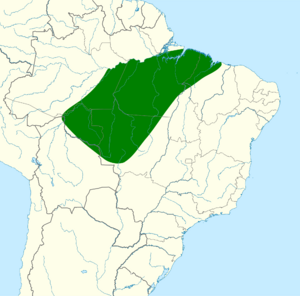Red-necked aracari facts for kids
Quick facts for kids Red-necked aracari |
|
|---|---|
 |
|
| P. b. bitorquatus in Arari, Brazil | |
| Conservation status | |
| Scientific classification | |
| Genus: |
Pteroglossus
|
| Species: |
bitorquatus
|
| Subspecies | |
|
See text |
|
 |
|
The red-necked aracari (Pteroglossus bitorquatus) is a colorful bird from the toucan family. It is found in parts of Bolivia and Brazil. This bird is known for its bright colors and unique bill.
Contents
About the Red-necked Aracari
The red-necked aracari is a type of bird called a near-passerine. This means it is not a true songbird, but it has some similar features. It belongs to the toucan family, which is known for its large, colorful bills.
Different Types of Red-necked Aracaris
Scientists group these birds into three main types, called subspecies. They are:
- P. b. sturmii
- P. b. reichenowi
- The P. b. bitorquatus (this is the original type)
Some bird experts think P. b. sturmii is a completely separate species. However, in this article, we will talk about all three as subspecies of the red-necked aracari.
What Does the Red-necked Aracari Look Like?
These birds are about 36 to 40 centimeters (14 to 16 inches) long. They weigh between 112 and 171 grams (4 to 6 ounces).
The main type, P. b. bitorquatus, has a special bill. The top part (maxilla) is yellow to greenish-white. It has black and white edges that look like teeth. The bottom part (mandible) is mostly black with a white base.
Adult males have a dark head and a red neck and chest. Their upper body is dark green, and their belly is yellow. Females look similar but have a browner head and a slightly different yellow band on their chest. Young birds are duller in color.
How Subspecies Are Different
- P. b. reichenowi looks like the main type but has less red on its chest. Its bill also has a jagged look where the black and white meet.
- P. b. sturmii is larger. It has a wider yellow band above its red chest. The "teeth" on its bill are not as clear. Its lower bill is mostly black with an orange-yellow base.
Where Do Red-necked Aracaris Live?
Each subspecies lives in a specific area:
- P. b. sturmii lives in north-central Brazil and eastern Bolivia.
- P. b. reichenowi is found in Brazil, south of the Amazon River.
- P. b. bitorquatus lives in northeastern Brazil, all the way to the Atlantic coast.
These birds like to live in different kinds of forests. They prefer moist tropical forests but can also be found in bamboo forests and older secondary forests. They live from sea level up to about 800 meters (2,600 feet) high.
Red-necked Aracari Behavior
How They Move Around
Red-necked aracaris usually stay in one area. They do not travel far from their homes.
What They Eat
These birds look for food from the middle of the forest up to the very tops of the trees. They can be alone, in pairs, or in small groups. Their main food is fruit. They also probably eat insects, eggs, and small animals.
Reproduction and Life Cycle
The breeding season for red-necked aracaris varies. In some places, it is from February to August. In others, it can be from April to September or even July to December. Like other toucans, they are thought to nest in holes in trees. Not much else is known about how they raise their young.
What Sounds Do They Make?
Red-necked aracaris make many different sounds. They can make repeated "tik" or "tek" notes. They also make "ttak" or "tyat" sounds. Sometimes, they make single "ik" notes, a "tweah," or growl-like, chattery "dcheeeaah" calls.
Protecting the Red-necked Aracari
The IUCN (International Union for Conservation of Nature) looks at the "western" and "eastern" red-necked aracaris separately.
The "western" type (P. b. sturmii) was once considered "Near Threatened." This means it might become endangered soon. But in late 2021, its status was changed to "Least Concern." This means it is not currently at high risk. Even though it lives in a large area, its numbers are thought to be going down.
The "eastern" type (P. b. reichenowi and P. b. bitorquatus) is listed as "Endangered." This means it is at a very high risk of disappearing. It also lives in a large area, but its population is decreasing. The biggest threat to both groups of red-necked aracaris is the cutting down of forests in the Amazon basin.
Images for kids





